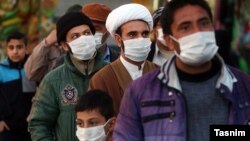Iran’s Ministry of Health on March 1 announced a significant increase in the number of diagnosed coronavirus cases by 385 to 987 patients and the number of deaths to 54 from 43 in the last 24 hours.
The largest number of new cases were in the capital Tehran, with 170 new diagnosis confirmed. Persian-language media abroad and many citizens have been expressing doubt about official numbers announced in the past ten days, insisting that many more have died and are infected with the virus.
As the coronavirus crisis deepens in Iran, the health ministry on March 1 ordered all public hospitals to refrain from admitting any non-emergency patients and prepare to deal with COVID-19 cases.
Qassem Jan-Babaei, a deputy health minister sent a letter to the directors of all government hospitals run by state university medical schools, issuing the new directive, ISNA semi-official news agency reported.
Iran reported its first cases of coronavirus infections and deaths on February 19, in what many say was a deliberate delay to inform the public, prior to parliamentary elections February 21, in order not to decrease participation in voting. So far, the official death toll stands at 43, with more than 500 diagnosed with the virus.
A person suspected of suffering from COVID-19 infection lies on a street in Iran's northeastern city of Mashhad.
Meanwhile, a Tehran city official announced that disinfectant solutions used to spray metro trains and buses in the capital have run out. There are 1,200 metro train cars and 6,000 public buses in Tehran, which Majid Farahani said were being sprayed every night to contain coronavirus.
Farahani told the official government news website IRNA March 1 that currently “non-standard” chemical solutions are being used and the government “has failed to provide standard” disinfectants for the city’s transportation authority.
Reports say traffic and inner-city trips have decreased in the capital, but air-pollution and smug have increased. The government has been using highly pollutant fuels to fire electricity-generating plants all winter.
Another Tehran city official says bus and taxi drivers have a hard time to obtain masks and gloves to protect themselves against the virus. Mehr news agency reports that regular masks originally costing a few cents are now sold for 30 cents. While this might seem as a good price in other counties, in Iran it is a lot of money for working people, who earn $100-400 a month.
Masks with filter now cost around $30 each, which only affluent people can afford.
Mehr also reports that prices for disinfectants have skyrocketed and out of reach for many citizens.
Local media reports that Health Minister Saeed Namaki has written a complaint letter to President Hassan Rouhani saying, “Unfortunately, after 10 days of crisis only one million masks have been delivered [to health authorities] and we don’t know where the rest are. My colleagues have to look day and night to find masks from merchants and smugglers, with very high prices.”
Another official told Tasnim news agency that government agents have discovered five million hoarded masks and five containers full of medical gloves. Owners of these caches have been ordered to sell their merchandise to retailers.
An official of Tehran Province water and sewage authority says that with increased attempts at hygiene water usage has gone up by 5 percent. Reports from other cities and provinces also indicate an increase in water consumption. As a result, some cities are experiencing lower water pressure.
Deep concern over the well-being of prisoners persists, with family members saying bad hygiene in prisons and cramped conditions can lead to a mass epidemic in correctional centers.
Many activists have launched online campaigns urging the government to release political prisoners, mostly considered victims of government repression rather than real offenders. In response, a few jailed journalists and activists have been given temporary “vacations” from prison but thousands are believed to be still in prisons.
Last November, Iran experienced its largest ever anti-government unrest and human rights organizations and independent media say up to 8,000 people were arrested and put in crowded prisons.






